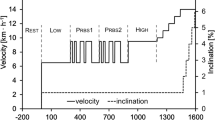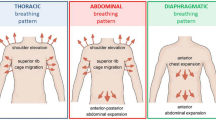Abstract
The purpose of our investigation was to analyse the breathing patterns of professional cyclists during incremental exercise from submaximal to maximal intensities. A group of 11 elite amateur male road cyclists [E, mean age 23 (SD 2) years, peak oxygen uptake (V˙O2peak) 73.8 (SD 5.0) ml · kg−1 · min−1] and 14 professional male road cyclists [P, mean age 26 (SD 2) years, (V˙O2peak) 73.2 (SD 6.6) ml · kg−1 · min−1] participated in this study. Each of the subjects performed an exercise test on a cycle ergometer following a ramp protocol (exercise intensity increases of 25 W · min−1) until the subject was exhausted. For each subject, the following parameters were recorded during the tests: oxygen consumption (V˙O2), carbon dioxide output (V˙CO2), pulmonary ventilation (V˙ E), tidal volume (V T), breathing frequency (f b), ventilatory equivalents for oxygen (V˙ E·V˙O2 −1) and carbon dioxide (V˙ E·V˙CO2 −1), end-tidal partial pressure of oxygen and partial pressure of carbon dioxide, inspiratory (t I) and expiratory (t E) times, inspiratory duty cycle (t I/t TOT, where t TOT is the time for one respiratory cycle), and mean inspiratory flow rate (V T/t I). Mean values of V˙ E were significantly higher in E at 300, 350 and 400 W (P < 0.05, P < 0.05 and P < 0.01, respectively); f b was also higher in E in most moderate-to-maximal intensities. On the other hand, V T showed a different pattern in both groups at near-to maximal intensities, since no plateau was observed in P. The response of t I and t E was also different. Finally, V T/t I and t I/t TOT showed a similar response in both P and E. It was concluded that the breathing pattern of the two groups differed mainly in two aspects: in the professional cyclists, V˙ E increased at any exercise intensity as a result of increases in both V T and f b, with no evidence of tachypnoeic shift, and t E was prolonged in this group at high exercise intensities. In contrast, neither the central drive nor the timing component of respiration seem to have been significantly altered by the training demands of professional cycling.
Similar content being viewed by others
Author information
Authors and Affiliations
Additional information
Accepted: 7 December 1998
Rights and permissions
About this article
Cite this article
Lucía, A., Carvajal, A., Calderón, F. et al. Breathing pattern in highly competitive cyclists during incremental exercise. Eur J Appl Physiol 79, 512–521 (1999). https://doi.org/10.1007/s004210050546
Issue Date:
DOI: https://doi.org/10.1007/s004210050546




